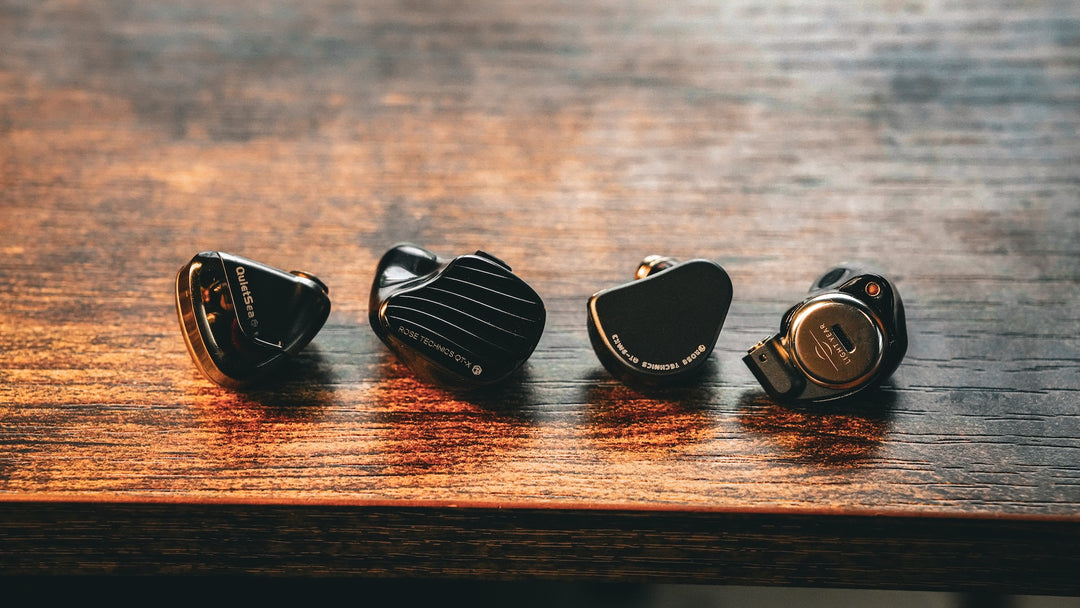Falcon Pro was a game changer when it was released a few short years ago. Noble Audio cracked the code to combine HiFi sound and TWS convenience in their revolutionary earphones. Since then each generation of Noble TWS has improved the sound and Bluetooth performance, bringing us to the FoKus Prestige. Prestige uses the FoKus Mystique as a starting point, and aims to elevate the sound quality, craftsmanship, and wireless audio technology into a total TWS package unlike any other. Does FoKus Prestige succeed, or is it just a pretty face on last year’s sound
Build and Design
Noble’s “Prestige” series IEMs represents the pinnacle of materials and design for the brand. This precision build and exemplary finish are typically reserved for $4000 custom IEMs. At $599 FoKus Prestige takes the concept and makes it more accessible, bringing the price of Prestige from the level of a Malibu mortgage payment down a little bit closer to a Volkswagen car payment. Probably my only disappointment in the build and design of FoKus Prestige is the packaging. The box and pack-ins are similar to the FoKus Mystique, with basic eartips, cable, and a cleaning cloth. It’s not until you get to the charging case and the IEMs themselves that you see what Prestige is all about.
The exterior of the case is appointed in precision CNC milled wood, and the inside is a more standard plastic. The IEMs themselves are entirely made of the same wood as the case, giving you a very cohesive, premium experience. The finish highlights the unique grain and cut of the wood, with transparent black or blue options. Since they’re made from wood and have a translucent finish, each set of FoKus Prestige will be just slightly different. The size and fit is essentially the same as the FoKus Pro and Mystique, making it just slightly above average size for an IEM. Getting eartips on the FoKus series has always been a bit harder on average, and Prestige doesn’t change that. While most standard tips will fit, it takes a little extra work to get them secure.
Using FoKus Prestige
While the build puts most TWS – and IEMs at any price point – to shame, FoKus Prestige only offers a pretty basic feature set. Prestige uses the same app as previous FoKus IEMs, which allows you to check your battery life, adjust touch settings, and easily update the firmware. You can also adjust your EQ through the app, or take a short hearing test for a custom EQ. Prestige does provide a transparency mode, but no ANC. “Listen through” mode can only be activated with the touch controls, so you can’t turn it on or off with the app. There’s also no ear detection, so you’ll want to double-check pausing your music when you put them back in the charge case.
The app was generally easy to use, and pairing through the phone and with the app was straightforward. If you plan on using FoKus Prestige with an Android based DAP, you should be aware that the app requires location services. This means that if you don’t have GPS on your DAP, you’ll need to use an additional app to “spoof” the GPS or else the app won’t work. This has been a problem with a number of TWS apps, which I was only able to find the solution for recently.
Sound
You could almost make the argument that, even if it was thoroughly average, FoKus Prestige might be worth it purely based on how the materials, design, and build quality exceed anything else on the market right now, but – lucky for you – you don’t have to make that argument: FoKus Prestige sounds great too. There’s nothing jaw-dropping, earth-shattering, or revolutionary about FoKus Prestige’s sound. It’s simply a great execution of a classic tuning. Prestige is a three-driver hybrid with two balanced armature drivers and one dynamic, and it delivers the sort of natural, slightly warm tuning that you’d expect from that driver selection.
The bass has nice extension, but is more focused in the midbass, where you get a good sense of impact and some warmth moving up into the midrange. One way Prestige separates itself from previous generations of the FoKus is an improved delivery of detail and texture in the bass.
That warmth extends to the lower mids, where Prestige provides good body in pianos and acoustic guitars. The vocals are slightly pulled back, putting them in the middle of the mix for a natural – not too close, not too far – presentation. The general sense of clarity and transparency in the midrange is excellent, giving you some of the best I’ve heard in a TWS.
The treble knows what it’s supposed to do, and does it well. The fundamentals are there, but don’t expect too much air or extension. There’s a good sense of fast attack and natural decay in the treble that gives Prestige a resolving feeling.
The soundstage is excellent for a TWS, providing a good sense of width and three-dimensionality. I particularly noticed the good sense of vertical space it provides. FoKus Prestige has a good general sense of positioning in the image, but it feels more blended and cohesive than holographic.
The chaotic introduction to jazz saxophonist Kamasi Washington’s “Miss Understanding” could get grating pretty quickly with the wrong headphones, but FoKus Prestige strikes the right balance of clarity and smoothness to keep your ears from bleeding. When the main groove hits, you get a full bodied, cohesive sound to the ensemble. The saxophone is smooth but nimble, while the bass has a nice tactile pluck. While Prestige’s delivery of the upper end of the saxophone and piano is more smooth, the accents from the cymbals add some air at the top of the mix. It’s hard to track in the busy arrangement, but there’s a good sense of placement and space in the instruments, with the piano and bass on the left and drums set a little further back off to the right, there’s an added feeling of realism, with nothing but the saxophone and kick feeling fully centered in the image.
On “Hollywood” by the Cranberries, there’s a warmth in picking of the opening chords that quickly gives way to the powerful attack of the full band. FoKus Prestige’s blend of fund and detail, gives you the energy of the Cranberries’ more grunge-y side, while also making the listener note the little bit of gloss coming from the high quality production. Dolores O’Riordan’s signature vocals are placed in the middle of the band, piercing through the mix. Prestige’s cohesive, natural presentation and strong imaging characteristics let you close your eyes and practically see the amps on the stage, and the dynamics emphasize the energy in the song’s soft/heavy/soft arrangement.
Hans Zimmer’s Dune score presents atmospheric soundscapes which weave melodic themes through a near constant ambient drone that ebbs and flows throughout the soundtrack. FoKus Prestige provides an immersive listening experience by first lulling you in with rich textures and then demonstrating excellent dynamics and layering. It captures the complexities of the composition as the theme builds to a climax, only to fade out into the next movement. Prestige’s soundstage isn’t quite up to the job of delivering the barren vastness of Arrakis that Zimmer captures in his score, but it comes surprisingly close.
Comparison: HIFIMAN Svanar Wireless ($499), Noble Audio FoKus Mystique ($359)
One of the biggest questions we had in this review was how different is FoKus Prestige from the FoKus Mystique. My initial assumption was that Prestige was just some fancy shells on the old IEM, but there are some sound and technical performance improvements to be found in Prestige as well.

Sonically, Prestige sounds clearer and provides stronger detail retrieval. While the bass quantity feels about the same, Prestige shaves off that little bit of bloat that Mystique experienced. That also makes room for just a little more of those fundamentals in the treble we mentioned earlier. In terms of the physical design, Mystique has a solid, quality build and a nice look to it, but Prestige blows pretty much everything out of the water in this category. On the technical end, Prestige has some upgrades to the Bluetooth chip and processing, and I found I had less pairing issues and better connection stability with Prestige than with Mystique.
Svanar Wireless offers a bit more competition in the sound department. The tunings are similar, but Svanar is slightly more neutral in the bass, with less midbass emphasis that also gives you a little more transparency in the midrange. Svanar has a wider soundstage than FoKus Prestige, but not quite as much depth. Svanar’s sense of separation in the image is a little stronger, but it can sometimes feel as if the space is exaggerated. Prestige doesn’t feel as wide, but fills the space in a more natural manner.

On the functional end of things, FoKus Prestige has a slight edge on account of having an app where Svanar Wireless doesn’t, but Svanar has ANC as well as LDAC support. In our testing the LDAC connection wasn’t as consistent as aptX or AAC, so while it’s there, the use is somewhat limited, particularly if you plan to travel with them. Svanar’s fit might be better suited for those who prefer a more shallow insertion, but Prestige provided a more secure fit for me.
The Bottom Line
Nailing all three elements of a TWS – build, features, and sound – seems to be an insurmountable challenge. Noble FoKus Prestige is perhaps the closest we’ve come yet. The build and materials are incredible, and the sound is among the best available in a TWS. If Prestige had ANC, it might have been the perfect TWS, but that just leaves something for Noble to strive for next time. However, if sound is king in your quest for the perfect TWS, FoKus Prestige gives you that sound, and makes craftsmanship its queen.









